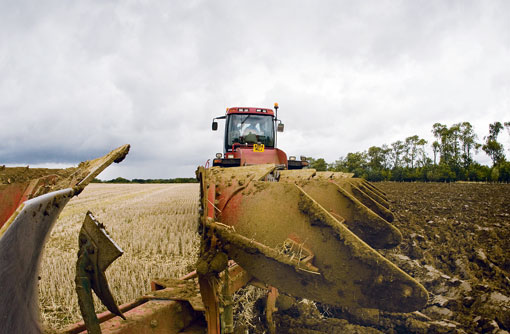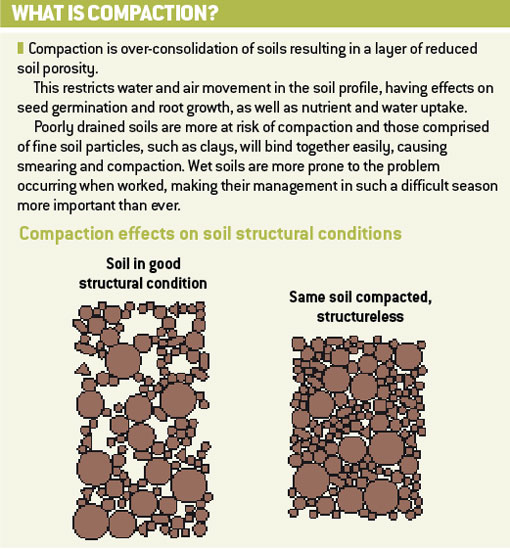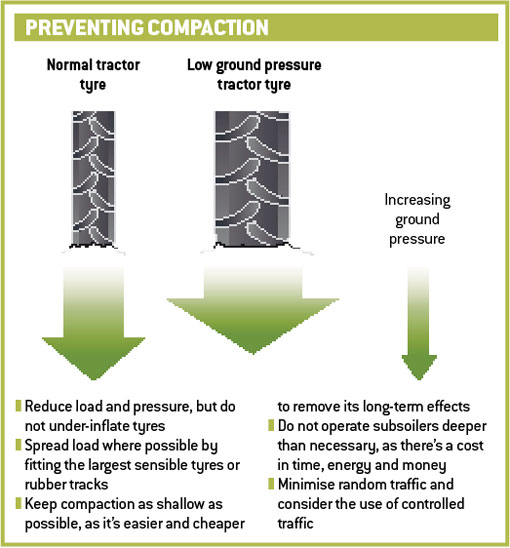Tips on tackling compaction after this year’s wet harvest
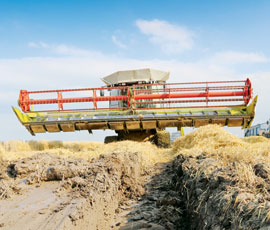
Most arable farmers will need to get the spade out and dig holes to assess the amount of damage done to soil structure after such a wet summer, agree industry experts.
Simply digging to the depth that you want to work to will highlight any problems, explains independent agronomist Simon Draper, as well as give a clear indication of the best way to correct them.
“Unfortunately, harvest machinery movements, coupled with heavy rainfall over the past four months, have combined to create compaction, even in soils which were previously in good condition,” he says.
“If you’re lucky, you can attempt to do an instant repair,” he says. “But they normally don’t work too well. The more usual procedure is to use the next 12 to 18 months to correct any affected areas.”
Squashed, wet soils need to dry out before they can be put right, he points out. “And that’s the issue on many farms at the moment. We need a dry spell of 10 days or so to help us out and get remedial action under way.”
Standing water, a common sight in combine wheelings this year, isn’t a major concern if the structure underneath is sound, he points out.
“The aim here is to get the standing water away and then try to get a crop in to help dry it out.”
Oilseed rape is often the best option for a badly mauled field, as the rape roots grow earlier and more vigorously than other crops and help to dry the ground out, he explains. “You can just broadcast it on the top of the field, rather than disturb the ground again. It’s almost using it as a cover crop.” But only untreated seed can be broadcast.
Even if resulting crops don’t win any beauty contests, they should still provide a decent margin and help the ground to recover. “It’s my preferred solution for most situations.”
Otherwise, winter barley is the next best option for a poor field, as it allows an early harvest and helps with timeliness where following cultivations are concerned. “Crop choice is important in these conditions.”
Leaving the worst fields for a spring barley crop is an alternative solution, he acknowledges. “Of course with this option, you are reliant on dry weather in the spring, or you are simply up against the same problem again.”
Mr Draper stresses the importance of determining whether soils are too wet to work, before any cultivations or remedial work begins.
“This is where the spade comes in. If you have good soil structure normally, digging just one spade depth is enough to tell you what you need to know.”
Taking some of the soil from that spade depth and forming it into a ball, before squeezing it to see if it breaks, is the best indicator. “If it cracks and breaks, it’s dry enough to work. If it doesn’t, it’s still too wet.”
Where subsoiling or ploughing is being considered, a hole of two spade depths is required. “Then repeat the ball forming and squeezing, with soil from the appropriate depth, to see if it can be worked.
“Remember a subsoiler will run just below the plough layer. If you’re intending to try and correct any soil structure damage, you will have to be working on the soil surface. So it must be dry enough to cope.”
Putting mole drains in is another possibility, notes Mr Draper. “But you need to know whether it is a drainage issue. You do really need to have a drainage scheme in place to mole over.”
Mole ploughing costs around £37-50/ha, he adds. “You would normally run mole drains around 20in deep. They don’t drain groundwater, just the water that enters from above.”
The soil must be stable enough for mole drains, he confirms. “They can be effective for up to 10 years on good land. But sometimes you get just three years’ benefit from them.”
He believes soil management is limiting yields in certain situations.
“We’ve seen improvements in varieties and agrochemicals, but wheat yields have reached a plateau. Now it’s time for growers to look at soils and consider the best way to manage them.”
What about drainage?
Drainage is paying for itself this year, as growers cope with the stop-start harvest and the urgent need to get preparations for the next crop under way, says Tim Sisson, managing director of William Morfoot.
“A good drainage scheme doesn’t stop the rain, but it does increase recovery time,” he says. “And timeliness is proving to be the main issue this year.”
However, any drainage is only as good as the surrounding ditch system, he cautions. “All too often, we find that the ditches are in a poor state. They must be maintained for drainage to work well.”
A comprehensive drainage scheme, with a pipe network every 20m and shingle over the pipes, will cost around £2, 000/ha, he confirms.
“Of course, that cost can vary enormously and there can be significant economies of scale. Done well, it will give you 20-25 years of service before you have to review it.”
The firm undertakes drainage schemes all year, working in standing crops where necessary, but is particularly busy after harvest. “We can install up to 8ha/day. We develop a strategy with the farmer to get the work done according to his workload.”
Having land in good order does pay for itself over time, he claims. “Growers have spent a great deal on inputs, to try and keep crops disease free, but if their soil structure and drainage isn’t right, they won’t be seeing the rewards.”
Where mole draining is being considered, the land must have a minimum clay content of 42%, advises Mr Sisson.
“It has to be able to hold the mole. Also, consider the gradient in the field, so the water can flow through drains and down the slope.”
Mole drains can be established every 40-60m, he adds. “And there must be an outlet for the water to drain away.”
He believes mole drains have a maximum life of six to seven years. “Of course, they erode more quickly in a wet year. During a wet harvest like this one, they get crushed and consolidated.”
Again, a spade comes in useful, he suggests. “You need to respond to the conditions. Dig a hole and have a look at your mole drains. That may need doing on a field-by-field basis.”
His final point concerns the state of existing drainage schemes, many of which were installed in the early 1980s, when there was grant aid.
“Unfortunately some of these schemes are expiring now and it’s time to look at renewing them. It’s inevitable they will start to break down, especially given the trend for bigger, heavier machinery.”
Land which is underperforming is often due to poor drainage, he adds. “Farming wet land is very difficult, as we are seeing this year. There’s a reason why well-drained land is worth more money.”
Time to review cropping plans
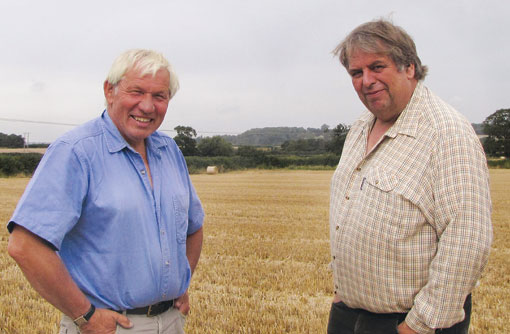
An exploratory dig by Simon Deaper (left) showed a plate had formed at a depth of 10cm in Mark Hollands’ barley stubble.
Grower Mark Hollands is reviewing his cropping plans after such a difficult, wet summer, in the hope of limiting any long-term detrimental effects on soil structure.
Test digs performed last year confirmed soil conditions on the 540ha combined from his base at Wootton Hill Farm were reasonable, allowing him to use shallow cultivations and direct drilling where appropriate on the clay loam soils.
But some 530mm of rain since the beginning of April 2012 has resulted in a very different situation ahead of drilling this year.
“We’ve had almost a year’s worth of rainfall in 21 weeks. The land is wetter than it’s ever been.
“As a result, this season we’ll have to work to a depth of 10cm just to deal with the combine ruts before any cultivation work can be done,” he says. “It’s only taken four months to undo all the good work that we’ve been doing on the farm for the past few years.”
At the time of writing, his land was too wet to work, giving him some difficult decisions to make in fields where oilseed rape was due to be drilled and the deadline was rapidly approaching.
“One block of land, which had barley on it before, has got combine wheelings which are a real concern and quite a bit of standing water. I hope to be able to spin some rape seed on to it, followed by a light cultivation, to help it dry out. It won’t look pretty, but it might work.
“Where I’ve still got wheat to harvest, there’s always the Autocast option. We haven’t ever had to use that.”
The combine harvester has done most of the damage, he admits. “The soil surface structure is the problem and it’s causing standing water to collect. The tramlines aren’t too bad.”
An exploratory dig of the wheelings with Mr Draper shows the main issue and confirms that the ground is still too wet for any disturbance. “A plate has formed at a depth of 10cm. If the combine had been on tracks, it would have helped, but it wasn’t. Flotation tyres are used on the trailers as a matter of routine.”
A dry spell would have allowed Mr Hollands to use his Sumo Trio cultivator, which normally works at a depth of 17-20cm. But further rain since our visit, together with the forecast for the next week or so, doesn’t suggest that this is likely to happen, making him consider other actions.
“I’ve had to take on the services of a contractor, who is going to plough as soon as it’s dry enough. Having spoken to Simon after another wet weekend, it’s the only option.
“It might buy me another week or so. But, if the rain continues, it will be a week before he can start.”
Shallow mole drains going straight into a ditch are also a possibility, he notes. “We need to get the standing water away quickly so that we can get the rape in. By mid-September it will be too late.”
Another option is the use of fallowing. “It’s a last resort, but it could be done. However, I’d still like to put a cover crop in, to help repair soil structure.”
Fields that had oilseed rape in are less of a concern, although there are still areas where the tyres sunk into the ground. “There are far too many wheelings for any direct drilling to take place, although this isn’t really the year for that technique anyway.”
One 8ha field on the farm is the site of a direct drilling trial, with four different drills being compared. Although the field has been harvested and the yield results are in, Mr Hollands is reluctant to make conclusions about drill performance on the basis of just one year.
“The whole field averaged 3t/acre. The wide-row drills didn’t do quite as well, as the crop brackled between the rows and the ears snapped off and fell on to the ground. It’s a particular problem with that type of drill in this season.”
But the fact that he was able to harvest the field has confirmed one of the advantages of direct drilling. “The land was in better condition and we could get on it.”
